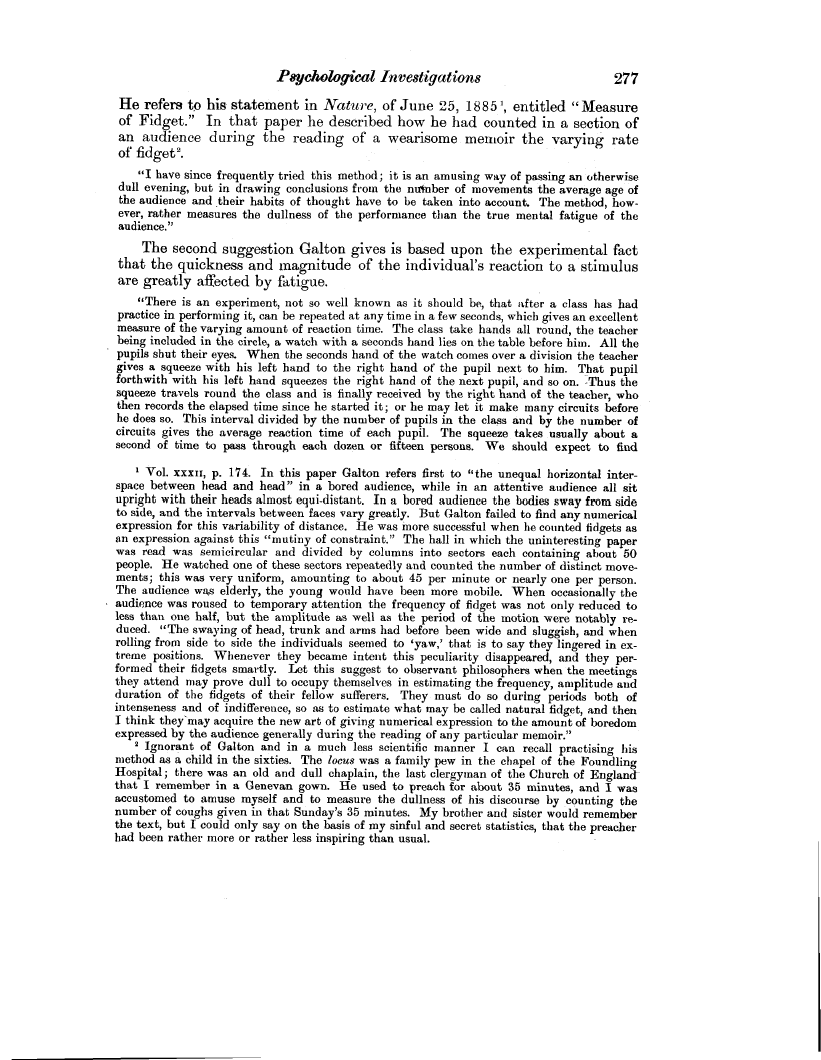Psychological Investigations 277
He refers to his statement in Nature, of June 25, 1885', entitled "Measure of Fidget." In that paper he described how he had counted in a section of an audience during the reading of a wearisome memoir the varying rate of fidget2.
"I have since frequently tried this method; it is an amusing way of passing an otherwise dull evening, but in drawing conclusions from the nu'knber of movements the average age of the audience and their habits of thought have to be taken into account. The method, however, rather measures the dullness of the performance than the true mental fatigue of the audience."
The second suggestion Galton gives is based upon the experimental fact that the quickness and magnitude of the individual's reaction to a stimulus are greatly affected by fatigue.
"There is an experiment, not so well known as it should be, that after a class has had practice in performing it, can be repeated at any time in a few seconds, which gives an excellent measure of the varying amount of reaction time. The class take hands all round, the teacher being included in the circle, a watch with a seconds hand lies on the table before him. All the pupils shut their eyes. When the seconds hand of the watch comes over a division the teacher gives a squeeze with his left hand to the right hand of the pupil next to him. That pupil forthwith with his left hand squeezes the right hand of the next pupil, and so on. -Thus the squeeze travels round the class and is finally received by the right hand of the teacher, who then records the elapsed time since he started it; or he may let it make many circuits before he does so. This interval divided by the number of pupils in the class and by the number of circuits gives the average reaction time of each pupil. The squeeze takes usually about a second of time to pass through each dozen or fifteen persons. We should expect to find
' Vol. xxxii, p. 174. In this paper Galton refers first to "the unequal horizontal interspace between head and head" in a bored audience, while in an attentive audience all sit upright with their heads almost equi-distant. In a bored audience the bodies sway from side to side, and the intervals between faces vary greatly. But Galton failed to find any numerical expression for this variability of distance. He was more successful when he counted fidgets as an expression against this "mutiny of constraint." The hall in which the uninteresting paper was read was semicircular and divided by columns into sectors each containing about 50 people. He watched one of these sectors repeatedly and counted the number of distinct movements; this was very uniform, amounting to about 45 per minute or nearly one per person. The audience wt s elderly, the young would have been more mobile. When occasionally the audience was roused to temporary attention the frequency of fidget was not only reduced to less than one half, but the amplitude as well as the period of the motion were notably reduced. "The swaying of head, trunk and arms had before been wide and sluggish, and when rolling from side to side the individuals seemed to 'yaw,' that is to say they lingered in extreme positions. Whenever they became intent this peculiarity disappeared, and they performed their fidgets smartly. Let this suggest to observant philosophers when the meetings they attend may prove dull to occupy themselves in estimating the frequency, amplitude and duration of the fidgets of their fellow sufferers. They must do so during periods both of intenseness and of indifference, so as to estimate what may be called natural fidget, and then I think they'may acquire the new art of giving numerical expression to the amount of boredom expressed by the audience generally during the reading of any particular memoir."
2 Ignorant of Galton and in a much less scientific manner I can recall practising his method as a child in the sixties. The locus was a family pew in the chapel of the Foundling Hospital; there was an old and dull chaplain, the last clergyman of the Church of Englandthat I remember in a Genevan gown. He used to preach for about 35 minutes, and I was accustomed to amuse myself and to measure the dullness of his discourse by counting the number of coughs given in that Sunday's 35 minutes. My brother and sister would remember the text, but I could only say on the basis of my sinful and secret statistics, that the preacher had been rather more or rather less inspiring than usual.

